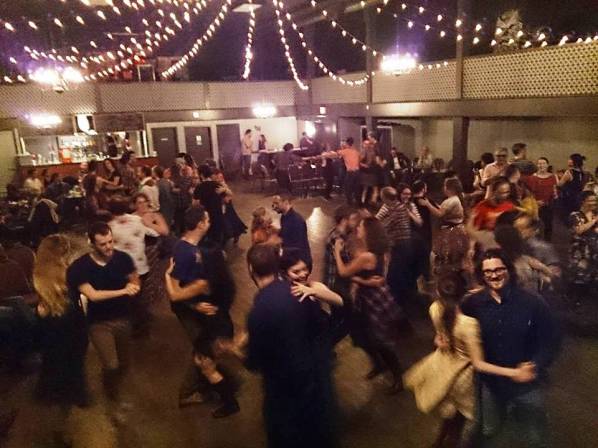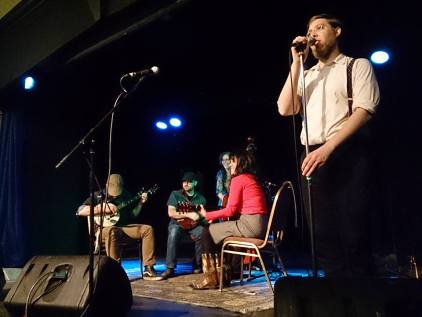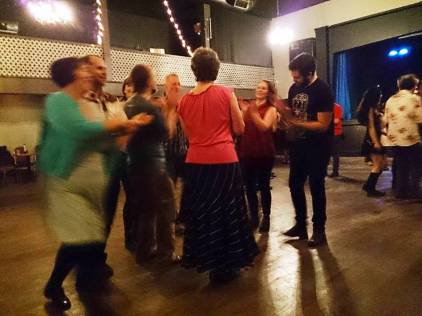
The scene at a recent square dance in Vancouver, BC.
The first time I ever square danced was in Hope, British Columbia.
This was a good six or seven years ago while I was attending a canoeing skills camping weekend retreat with a group of friends. I’m as outdoorsy as the next person, but not specifically into canoeing.
Rather than a desire to perfect my J-stroke, I recall my decision to tag along having more to do with FOMO and, if I’m to be honest with myself, the possibility of meeting new people (read: single guys) since the present object of my affection – who was also in attendance and a skilled canoeist – couldn’t care less about me in that way.
We arrived in shifts at the campground on Friday after work following many flustered discussions about departure times, pickup routes, and which type of music was and was not permitted in which car.
Within about 30 seconds of arriving, I noted we were the youngest people there. By a good 30 years at a minimum.
To the more canoe-inclined among my party, this was an exciting prospect – the opportunity to learn skills from paddlers with several decades of experience.
But for me, not only would I not have the chance to make my crush jealous, I was aghast at what these old people had lined up for entertainment. Saturday night square dancing? Seriously? Didn’t the very name – square dancing – pretty much say it all?
And with old people? As if square dancing with old people – with any people – would be fun.
As it turns out, it was.
Seriously fun.
In truth, among the most fun I’ve ever had with anyone anywhere, to the point that there’s little else I remember about that weekend besides the square dancing.
Which is probably why my J-stroke still sucks to this day.
Do try this at home
In the intervening years, I’ve attended two more square dances – most recently, just three weeks ago – which isn’t nearly enough for my liking.
(I’ve already decided that if I ever get married, there will be square dancing at the reception. Consider yourselves warned.)
Square dancing is easily my most hipster hobby, although I love it with all my heart, and as un-ironically possible.
For those unfamiliar with square dancing, it’s an old-time folk or county dance comprising four couples (eight people) arranged in a square, one couple per side and everyone facing each other and the square’s center.

The caller and the live folk band in Vancouver
The movements of the dance are directed by a caller, who calls out a sequence of steps that involve interaction with either your partner, your “corner” (the person on your opposite side from your partner), or one or both members of any or all of the remaining couples, the result often being the formation of various geometric figures and repeated patterns.
The music associated with square dancing – at least in North America – tends to be lively American folk or bluegrass.
If you haven’t tried square dancing, you’re truly missing out on something special. One good thing about a square dance is that you don’t necessarily need to arrive with a partner. At all three square dances I’ve attended, people who showed up single were still able to participate, especially as various halves of couples needed a break (square dancing can be quite the workout!)
Another square dancing advance is the presence of the caller to tell you exactly how to move.
Traditional square dancing (as opposed to the modern Western style) involves only a limited number of calls so that inexperienced dancers can learn on the fly rather than through a series of lessons. As well, at all three of my past dances, the caller demonstrated all the necessary steps before each round.
In not having to use your imagination to come up with your own dance moves to make yourself look good, square dancing is very low pressure, with the potential for unknowingly embarrassing yourself with an Elaine-from-Seinfeld dance all but impossible.
Fun facts (in addition to just plain fun)
The thing that interests me most about square dancing, though, is how it seems to be such a cultural artifact of its time.

A square up close in Vancouver
Nowhere does this appear more evident than in the names of the calls. Many of them directly reflect Old West activities and society, such as Duck for the Oyster, Shoot the Tin Can, Box the Gnat, Stack the Wood, and Weave the Ring. Each partner in a couple is also given a folksy moniker like “Birdie” or “Ma” for the female and “Crow” or “Pa” for the male.
There are also a surprising number of calls whose names are corrupted from French; indeed some of the most recognizable square dance moves follow this pattern: Do Si Do (dos a dos, meaning “back to back”), Allemande Left and Allemande Right (a la main, or “by hand”), Sashay (chassé, meaning “chase” or “hunt”), and Promenade (pronounced “prom-in-AID” instead of “prom-NAD” and meaning “walk”).
Hearing those French calls again at my most recent square dance suddenly made me very curious about square dancing’s origins and how so many French words wound up in such an American custom. According to Wikipedia [1] [2]:
- Other than the Modern Western style, square dancing is non-standardized. More than one style exists, with further regional variations within each of the main geographic regions where it’s commonly performed: Canada and the US, England, Ireland, and Scotland.
- The type of music and instruments used for square dancing in different countries often differs greatly from American folk (other instruments used include the piano, accordion, hammered dulcimer, saxophones, drums, and electric guitars). Modern Western square dancing is danced to a variety of music types, including pop, rock, contemporary country, and hip-hop.
- Square dancing has Old World origins. It was first documented in 17th century England, France and other parts of Europe and today descends from a number of traditional folk and social dances, including Morris Dance (medieval English folk dancing), English Country Dance, and the Quadrille (18th century French square dancing – A/N: perhaps the source of those French calls).
- Square dancing was brought to North America with European settlers, wherein it underwent many changes and is now largely considered an American custom. This is perhaps due to its association in the 20th century with the romanticized image of the American cowboy.
- Traditional Western American square dancing is perhaps the most widely known style worldwide, although there are regional differences in American square dancing across the northeast, southeast, and within west itself as well.
- Nineteen US states have square dancing as their official state dance.
One final point from Wikipedia mentions that in many cities and college towns, there exist revival groups dedicated to keeping square dancing alive and introducing it to the public.
Here in Vancouver, I’ve discovered there is indeed a growing square dancing scene. It’s one that I definitely plan to seek out and take part in.
Have you ever square danced? Have you ever tried any other form of non-mainstream dance? Which is your favourite? Tell me about it in the comments.
(Images: J.G. Noelle)

I pretty much avoid mainstream and non-mainstream dance, as it wouldn’t suit my character and reputation to have fun or be uninhibited.
We used to have to square-dance in gym class, believe it or not, up until 7th grade I think. As you pointed out, it’s a good workout. Although I can’t say I enjoyed it, I did have the unusual and scary yet exciting experience of two girls fighting over me as a dance partner one day. As the official wallflower of the class, I feared I had slipped into an alternate universe where I was popular. I still can’t explain it.
I had a chance to go a few years ago but declined. My significant other, not to be deterred, took a friend of mine instead. They peeked in the window and saw, just like you experienced, that everyone else there was 60+, so they bolted.
LikeLike
so they bolted
Oh no! That was the complete opposite outcome to my experience, though. Rather than bolt, I discovered that square dancing is so awesome, it doesn’t matter the ages of the participants.
I never used to like dancing of any sort; I wasn’t particularly comfortable with my body nor with the stereotype that black people are supposed to be good dancers. However, I started going to a Bollywood dance workout class a few years ago with a friend and it was so fun and the music so pulsing (“like a nightclub in Mumbai”, as I’m fond of describing it), I couldn’t help get into it. It really helped me let go of my insecurities. Now I love dancing of all types and am a little more stereotypical than I used to be, I fear.
LikeLike
I, on the other hand, am perfectly comfortable with the stereotype that white people can’t dance, especially since it’s true in my case. You’d think someone who plays the drums would be able to move to the rhythm.
If I’m ever in Vancouver, I’ll go square-dancing. You’ll be my inspiration. Unless you’re embarrassed to be seen with me, which, if you had any sense, you would be. 😉
LikeLike
If I’m ever in Vancouver, I’ll go square-dancing.
I’m holding you to that. But don’t worry – everyone who square dances in Vancouver is young and hipster so you’ll probably be the oldest one there. 😉
LikeLike
Being the oldest one there happens with increasing frequency. **sigh**
LikeLiked by 1 person
Never square danced but not opposed to trying! Just like I went bouldering recently and was an almost total failure but still enjoyed it!
LikeLike
Square dancing is brilliant and I do highly recommend it if the opportunity ever presents itself. Bouldering is a different kind of fun – there’s a lot of thinking involved, which I don’t always like in my physical activity (I prefer to just let my mind go blank and for my body to move by instinct; this is why I enjoy running so much). I remember the first time I tried bouldering, my hands hurt so much the next day, I couldn’t squeeze my toothpaste tube (I had to lie it on the counter and lean on it to get the toothpaste out!)
LikeLiked by 1 person
My first bouldering my fingers swelled so much I was frightened! I totally get that 🙂 I hate running in gyms but enjoy it when I can go on a trail. I’m really, really slow though!
LikeLike
Slow is better than stationary. 🙂
LikeLiked by 1 person
Pingback: Salome, Where She Danced – [Public Domain Movies] | mostly music